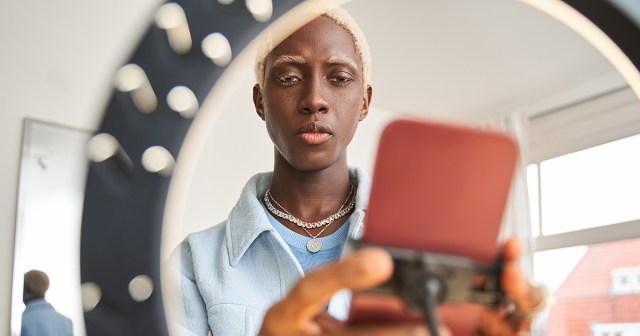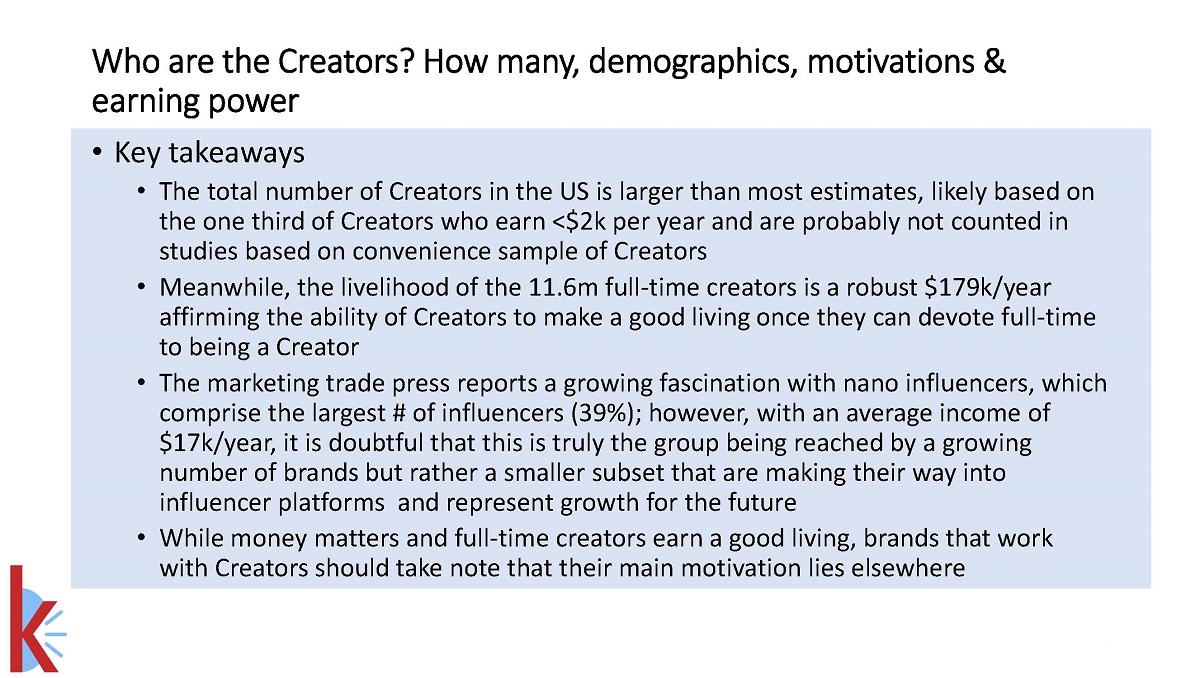
TL;DR
- A national poll identified 27 million people, or 14% of 16 to 54-year-olds, working as “influencers” in the US economy.
- The creator economy could be a $480 billion industry by 2027 as it continues to grow a sizable business ecosystem around social media stars.
- Yet traffic and wealth tends to be concentrated among a very few creators with less than 10% of full-timers earning a decent wage and the vast majority making less than $2,000 a year.
- The latest innovation driving the creator economy forward is artificial intelligence.
While there is near universal agreement about the growing size and importance of the creator economy, estimates vary widely. For example: Citi estimates there are more than 120 million content creators generating $60 billion of revenue, a figure which it estimates is growing at about 10% per year.
Goldman Sachs research has a very different estimate, saying the total addressable market of the creator economy could roughly double in size over the next five years to $480 billion by 2027 from $250 billion today.
Meanwhile, it estimates there are presently 50 million global creators, growing at 10-20% per year — far less than Citi.
READ MORE: The Creator Economy — Getting Creative and Growing (Citi)
READ MORE: The creator economy could approach half-a-trillion dollars by 2027 (Goldman Sachs)
In a national poll of 5,854 Americans market researcher Keller identified 27 million people, or 14% of 16 to 54 year olds, working as “influencers” in the US economy.

However, there is consensus that growth has not stopped and will be driven by investment in influencer marketing and the rise of ad-revenue-share models, particularly in short-form video on platforms like Instagram, TikTok, and YouTube.
As Goldman Sachs puts it, creators earn income primarily through direct branding deals to pitch products as an influencer; via a share of ad revenues with the host platform; and through subscriptions, donations and other forms of direct payment from followers. Brand deals are the main source of revenue at about 70%, according to its data.
eMarketer’s Insider Intelligence forecasts that in 2024, US influencer-marketing spend will hit $5.89 billion, and that its growth will “remain in the double digits through 2025.“
READ MORE: 5 charts showing the creator economy’s recent evolution (Insider Intelligence)
“The funds are not drying up anytime soon and we are seeing more and more people becoming creators,” Shannae Ingleton Smith, president and CEO of Kensington Grey Agency tells Amanda Perelli at Business Insider. “It’s a viable career space and in many cases pays more than the top tech jobs. Where the advertising dollars are, to me, is a great indication of sustainability.”
Since its inception in the mid-2000s the creator economy has also grown to encompass a range of professionals who work for creators. These range from managers to video editors, as well as tech execs who have built platforms and companies to help creators make money and build audiences.
READ MORE: The creator economy is a $250 billion industry and it’s here to stay (Business Insider)
“Social media was a tool for interacting with friends, but now it includes a vast ecology of people making money from posts or advertising,” Cristina Criddle explains at the Financial Times.
She interviews Kate Lingua-Marina, a creator known by her handle @SiliconValleyGirl, who explains that she made my first video in 2014 while applying to universities in the United States. She decided to document her journey — and her views exploded to the point that she now has three YouTube channels and a vlogging channel.
“I used to film everything myself,” Lingua-Marina says. “These days I have videographers who helped me from time to time depending on the type of content that I’m creating. I have several editors to help me with editing. If someone helps me post on platforms. I have a manager who’s responsible for working with brands.”
Top earners have built large teams, like the roughly 250-person operation assembled by MrBeast, who Forbes estimated made $82 million between June 2022 and June 2023.
READ MORE: Find me a zebra and you can have the job (Business Insider)
READ MORE: Top Creators 2023 (Forbes)
But not everyone can be a MrBeast. In fact, no one should be mistaken that becoming an influencer is an easy way to make money.
Only about 4% of global creators are deemed professionals, meaning they pull in more than $100,000 a year, finds Goldman Sachs.
A recent survey of 689 creators by the influencer-marketing platform Mavrck found about 51% made less than $500 a month. In the survey, nearly a quarter of creators said they earned more than $2,000, and about 4% said they earned more than $10,000 per month.
READ MORE: 51% of creators make less than $500 per month, according to a new survey (Business Insider)
Keller’s research concluded that 6% of Americans full-time creators and earn an average of $179,000 per year but that the average income is $93,000 per year. More than half of creators make less than $10,000 annually and a third only make $2,000.
“While the livelihood of the 11.6 million full-time creators (in the States) is a robust $179K/year, the total number of creators is larger than most estimates, likely based on the one third of them who earn less than 2K a year,” the researcher notes.


READ MORE: Creators Uncovered: Insights from a Nationally Representative Study of US Creators (Keller Advisory Group)
The creative economy is also facing mixed financial signals. After a flat 2022 YouTube ad revenues were up around 5% by the third quarter of 2023. Creators received just over half of the ad revenue generated on their channels. On the other hand, investment in the creative economy has dropped sharply with total funding for us startups fell 50% last year compared to 2021.
Revenue and funding going into platforms has decreased quite dramatically.
Criddle says, “One key problem for the creator economy is that creator traffic and wealth tends to be concentrated among the very few, such as MrBeast. Only 4% of creators are defined as professionals earning at least $100,000 a year.”
While the creative economy might be moving away from past explosive growth, there is evidence consumers remain willing to pay for quality content.
“The days of wild growth might be over or at least on hold but that’s not going to stop the millions of creators out there,” Criddle says. “There is enough demand, enough supply and now is the time when the focus should shift from quantity to quality.”
AI Comes to the Creator Economy
The latest innovation driving the creator economy forward is artificial intelligence.
This year, YouTube unveiled new AI tools and features aimed at simplifying content creation. According to Business Insider, the industry is betting on AI not to replace creators, but to increase productivity and bring more opportunities for people to make content.
Rising AI startups in the creator economy like Crate, an AI platform helping creators streamline the creative process, and Midjourney, an AI model that can generate images, are winning over investors.
READ MORE: Top investors name the 14 most promising creator economy startups in 2023, from Beehiiv to Midjourney (Business Insider)
Keller’s survey found half of Creators saying they want to start working with AI and that virtual reality/augmented reality is #2 on their list of tech they’d like to engage with in the future.
In a recent survey of 2,000 influencers by membership platform Creator Now, 90% said they were using ChatGPT during the content creation process, and 31% said they were using Midjourney. The top reason cited for using AI was to increase the speed of content creation. AI tools can edit TikTok or YouTube videos in a fraction of the time it takes today.
READ MORE: How creators are using AI: A survey of 2,000 influencers delves into the top tools, ethical dilemmas, and more (Business Insider)
“AI is a game changer,” says a creator speaking to the Financial Times. “The first time we used it was to create a script. I had to change some things, but it was right there in front of me in 60 seconds.
“If I create an AI version of myself, if AI create scripts, then my job is to decide which content goes out there and which topic my AI prototype is talking about. Good creators are becoming producers.”
WATCH MORE: The creator economy is changing, but can it thrive? (Financial Times)
“It’s going to start to split off. The creators who really want to stay in the game are going to learn how to work with A.I.,” Edelman VP of Influencer Marketing Myisha Moore tells the New York Times.
She expects that artificial intelligence tools will drive the professionalization of the influencer class. Moore explains, creators are “going to amplify their creativity to a new level. They’re going to come back with insights into the audience and say, ‘I’m going to set you apart.’ The ones who are having fun, making a little passive income — they’re going to find it harder to create.”


